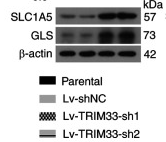Glutaminase Antibody - #DF13334
| Product: | Glutaminase Antibody |
| Catalog: | DF13334 |
| Description: | Rabbit polyclonal antibody to Glutaminase |
| Application: | WB IHC IF/ICC |
| Cited expt.: | WB |
| Reactivity: | Human, Mouse, Rat |
| Prediction: | Pig, Horse, Sheep, Rabbit, Dog, Chicken, Xenopus |
| Mol.Wt.: | 73kDa; 73kD(Calculated). |
| Uniprot: | O94925 |
| RRID: | AB_2846353 |
Related Downloads
Protocols
Product Info
*The optimal dilutions should be determined by the end user. For optimal experimental results, antibody reuse is not recommended.
*Tips:
WB: For western blot detection of denatured protein samples. IHC: For immunohistochemical detection of paraffin sections (IHC-p) or frozen sections (IHC-f) of tissue samples. IF/ICC: For immunofluorescence detection of cell samples. ELISA(peptide): For ELISA detection of antigenic peptide.
Cite Format: Affinity Biosciences Cat# DF13334, RRID:AB_2846353.
Fold/Unfold
AAD20; DKFZp686O15119; FLJ10358; GAC; GAM; GLS; GLS1; GLSK_HUMAN; Glutaminase C; Glutaminase kidney isoform; Glutaminase phosphate activated; K-glutaminase; KGA; KIAA0838; L-glutamine amidohydrolase; mitochondrial;
Immunogens
A synthesized peptide derived from human Glutaminase, corresponding to a region within C-terminal amino acids.
Isoform 1 and isoform 3 are detected in brain cortex. Isoform 3 is highly expressed in astrocytoma, ganglioglioma and ependymoma. Isoform 1 is highly expressed in brain and kidney, but not detected in liver. Isoform 3 is highly expressed in heart and pancreas, detected at lower levels in placenta, lung, pancreas and kidney, but is not detected in liver. Isoform 2 is expressed in cardiac and skeletal muscle.
- O94925 GLSK_HUMAN:
- Protein BLAST With
- NCBI/
- ExPASy/
- Uniprot
MMRLRGSGMLRDLLLRSPAGVSATLRRAQPLVTLCRRPRGGGRPAAGPAAAARLHPWWGGGGWPAEPLARGLSSSPSEILQELGKGSTHPQPGVSPPAAPAAPGPKDGPGETDAFGNSEGKELVASGENKIKQGLLPSLEDLLFYTIAEGQEKIPVHKFITALKSTGLRTSDPRLKECMDMLRLTLQTTSDGVMLDKDLFKKCVQSNIVLLTQAFRRKFVIPDFMSFTSHIDELYESAKKQSGGKVADYIPQLAKFSPDLWGVSVCTVDGQRHSTGDTKVPFCLQSCVKPLKYAIAVNDLGTEYVHRYVGKEPSGLRFNKLFLNEDDKPHNPMVNAGAIVVTSLIKQGVNNAEKFDYVMQFLNKMAGNEYVGFSNATFQSERESGDRNFAIGYYLKEKKCFPEGTDMVGILDFYFQLCSIEVTCESASVMAATLANGGFCPITGERVLSPEAVRNTLSLMHSCGMYDFSGQFAFHVGLPAKSGVAGGILLVVPNVMGMMCWSPPLDKMGNSVKGIHFCHDLVSLCNFHNYDNLRHFAKKLDPRREGGDQRVKSVINLLFAAYTGDVSALRRFALSAMDMEQRDYDSRTALHVAAAEGHVEVVKFLLEACKVNPFPKDRWNNTPMDEALHFGHHDVFKILQEYQVQYTPQGDSDNGKENQTVHKNLDGLL
Predictions
Score>80(red) has high confidence and is suggested to be used for WB detection. *The prediction model is mainly based on the alignment of immunogen sequences, the results are for reference only, not as the basis of quality assurance.
High(score>80) Medium(80>score>50) Low(score<50) No confidence
Research Backgrounds
Catalyzes the first reaction in the primary pathway for the renal catabolism of glutamine. Plays a role in maintaining acid-base homeostasis. Regulates the levels of the neurotransmitter glutamate, the main excitatory neurotransmitter in the brain.
Lacks catalytic activity.
Synthesized as a 74-kDa cytosolic precursor which is proteolytically processed by the mitochondrial-processing peptidase (MPP) via a 72-kDa intermediate to yield the mature mitochondrial 68- and 65-kDa subunits.
Mitochondrion. Cytoplasm>Cytosol.
Note: The 74-kDa cytosolic precursor is translocated into the mitochondria and processed via a 72-kDa intermediate to yield the mature 68- and 65-kDa subunits.
Mitochondrion.
Mitochondrion matrix.
Note: Produced by the proteolytic processing of the 74-kDa cytosolic precursor.
Mitochondrion matrix.
Note: Produced by the proteolytic processing of the 74-kDa cytosolic precursor.
Isoform 1 and isoform 3 are detected in brain cortex. Isoform 3 is highly expressed in astrocytoma, ganglioglioma and ependymoma. Isoform 1 is highly expressed in brain and kidney, but not detected in liver. Isoform 3 is highly expressed in heart and pancreas, detected at lower levels in placenta, lung, pancreas and kidney, but is not detected in liver. Isoform 2 is expressed in cardiac and skeletal muscle.
The C-terminal ANK repeats prevent the assembly of the supra-tetrameric filaments.
A highly mobile activation loop at the dimer-dimer interface is important for enzyme activity.
Belongs to the glutaminase family.
Research Fields
· Human Diseases > Cancers: Overview > MicroRNAs in cancer.
· Human Diseases > Cancers: Overview > Central carbon metabolism in cancer. (View pathway)
· Metabolism > Amino acid metabolism > Arginine biosynthesis.
· Metabolism > Amino acid metabolism > Alanine, aspartate and glutamate metabolism.
· Metabolism > Metabolism of other amino acids > D-Glutamine and D-glutamate metabolism.
· Metabolism > Global and overview maps > Metabolic pathways.
· Organismal Systems > Nervous system > Glutamatergic synapse.
· Organismal Systems > Nervous system > GABAergic synapse.
· Organismal Systems > Excretory system > Proximal tubule bicarbonate reclamation.
References
Application: WB Species: Human Sample: EC cell
Restrictive clause
Affinity Biosciences tests all products strictly. Citations are provided as a resource for additional applications that have not been validated by Affinity Biosciences. Please choose the appropriate format for each application and consult Materials and Methods sections for additional details about the use of any product in these publications.
For Research Use Only.
Not for use in diagnostic or therapeutic procedures. Not for resale. Not for distribution without written consent. Affinity Biosciences will not be held responsible for patent infringement or other violations that may occur with the use of our products. Affinity Biosciences, Affinity Biosciences Logo and all other trademarks are the property of Affinity Biosciences LTD.




